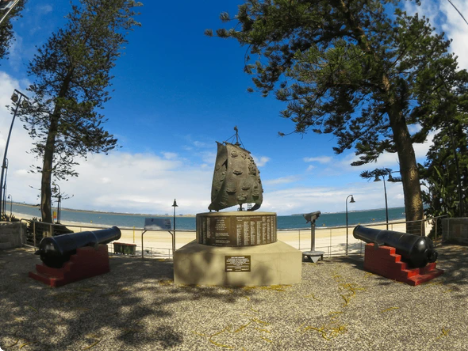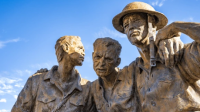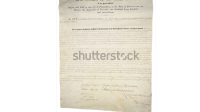Introduction: The Arrival of the First Fleet
The arrival of the First Fleet at Botany Bay in 1788 marks the beginning of a new era in Australian history. This event signaled the establishment of the first British colony on the continent, setting in motion a series of changes that would profoundly shape the future of Australia. The First Fleet, consisting of 11 ships carrying convicts, marines, and officers, arrived at Botany Bay after a grueling journey from England, marking the beginning of European settlement in Australia.
The decision to establish a penal colony in New South Wales was driven by a variety of factors, including overcrowded prisons in Britain, the loss of the American colonies, and the strategic importance of securing new territories in the Pacific. The arrival of the First Fleet and the subsequent establishment of the colony at Sydney Cove laid the foundation for modern Australia, while also initiating a period of significant upheaval and challenges for the Indigenous peoples of the region.
Read also : Captain James Cook Claims New South Wales for Britain (1770) : The Beginning of British Australia
The Decision to Establish a Penal Colony: Background and Motivations
The decision to establish a penal colony in New South Wales was the result of a combination of social, economic, and political factors in late 18th century Britain. Understanding these motivations provides insight into why the British government chose to send convicts halfway across the world to a distant and largely unknown land.
Overcrowding in British Prisons
By the late 18th century, Britain’s prison system was facing a crisis. The country’s prisons were overcrowded and conditions were dire, with disease, violence, and poor sanitation rampant. The situation was exacerbated by the loss of the American colonies, which had previously served as a destination for transported convicts. With no viable alternative, the British government began to search for a new location to send its convicts.
The overcrowding of British prisons was a significant problem that required an urgent solution. The increasing crime rates, driven by economic hardship and social inequality, led to a surge in the number of people sentenced to transportation. The need to relieve the pressure on the prison system became a driving force behind the decision to establish a new penal colony in Australia.
Strategic and Economic Interests in the Pacific
In addition to solving the problem of overcrowded prisons, the British government had strategic and economic motivations for establishing a colony in the Pacific. The loss of the American colonies during the Revolutionary War had diminished Britain’s global influence, and the government was eager to establish new territories to maintain its status as a world power.
Australia’s location in the Pacific was strategically significant, offering a potential base for trade and military operations in the region. The British government recognized the value of securing this territory before other European powers, such as France, could establish a presence. The establishment of a colony in New South Wales was seen as a way to protect British interests in the Pacific and expand the empire’s reach.
The economic potential of Australia also played a role in the decision to establish a colony. The British government hoped that the new settlement would provide valuable resources, such as timber and flax, which were in demand for shipbuilding and other industries. The colony was also expected to open up new trade routes and opportunities for economic growth.
The Role of Captain Arthur Phillip
Captain Arthur Phillip, a naval officer with experience in exploration and colonial administration, was chosen to lead the First Fleet and serve as the first Governor of New South Wales. Phillip’s leadership and vision were instrumental in the success of the colony, despite the numerous challenges he faced.
Phillip was tasked with overseeing the establishment of the colony, maintaining order among the convicts and settlers, and ensuring the survival of the settlement in an unfamiliar and often harsh environment. His pragmatic approach and determination were key factors in the colony’s ability to overcome the initial difficulties and establish a foothold in Australia.
Phillip’s role in the establishment of the colony extended beyond his administrative duties. He was also responsible for the initial interactions with the Indigenous peoples of the region and for laying the foundations of the colony’s legal and social structures. His leadership during this critical period set the tone for the development of the colony in its early years.
The Journey of the First Fleet: Challenges and Hardships
The journey of the First Fleet from England to Australia was a monumental undertaking, involving months of preparation, treacherous seas, and numerous challenges. The voyage was marked by hardships, including disease, shortages of food and water, and the difficulties of maintaining discipline among the convicts.
The Composition of the First Fleet
The First Fleet consisted of 11 ships, including two naval escorts, six convict transports, and three supply ships. The fleet carried approximately 1,400 people, including 736 convicts (580 men and 256 women), marines, officers, and a small number of free settlers. The ships were heavily laden with supplies, equipment, and livestock needed to establish the new colony.
The convicts aboard the First Fleet came from various backgrounds, many having been convicted of petty crimes such as theft. The decision to transport convicts to Australia was seen as a way to alleviate the overcrowded prisons in Britain while also providing a labor force for the new colony.
The officers and marines aboard the First Fleet were responsible for maintaining order and discipline during the voyage and in the colony. Their role was crucial in ensuring the success of the expedition and the establishment of the settlement upon arrival in Australia.
The Voyage: A Grueling Journey Across the Seas
The voyage of the First Fleet began in May 1787, departing from Portsmouth, England. The journey to Australia covered approximately 15,000 miles and took eight months to complete. The fleet made several stops along the way, including in Tenerife, Rio de Janeiro, and Cape Town, to replenish supplies and allow the crew and passengers some respite from the harsh conditions at sea.
The journey was fraught with challenges, including rough seas, storms, and the threat of disease. The cramped and unsanitary conditions aboard the convict ships led to outbreaks of scurvy, dysentery, and other illnesses. Despite these difficulties, the fleet managed to reach its destination with relatively few deaths, a testament to the planning and leadership of Captain Arthur Phillip.
The hardships endured during the voyage were a harbinger of the challenges that would await the settlers upon their arrival in Australia. The need to maintain discipline, manage limited resources, and ensure the survival of the colony would continue to be pressing concerns for Phillip and his officers.
The Arrival at Botany Bay
The First Fleet arrived at Botany Bay in January 1788. Botany Bay had been chosen as the site for the new colony based on the recommendations of Captain James Cook, who had visited the area during his voyage in 1770. However, upon arrival, Phillip quickly realized that Botany Bay was not suitable for a settlement due to its poor soil, lack of fresh water, and exposure to the elements.
After assessing the situation, Phillip decided to explore other potential sites for the settlement. He led an expedition to nearby Port Jackson, where he discovered a natural harbor with deep water, fertile soil, and a reliable source of fresh water. Phillip chose this location, which he named Sydney Cove, as the site for the new colony.
The decision to relocate the settlement from Botany Bay to Sydney Cove was a critical moment in the history of the colony. Sydney Cove offered more favorable conditions for settlement and would become the heart of the new colony of New South Wales.
Establishing the Colony: The Early Years at Sydney Cove
The early years of the colony at Sydney Cove were marked by a struggle for survival. The settlers faced numerous challenges, including food shortages, conflicts with Indigenous peoples, and the difficulties of building a settlement in an unfamiliar and often hostile environment.
Building the Settlement
Upon arriving at Sydney Cove, the settlers began the arduous task of building the new colony. The first priority was to construct shelters, storehouses, and other essential structures. The convicts, under the supervision of the officers and marines, were put to work clearing land, building huts, and establishing the basic infrastructure needed to sustain the settlement.
The construction of the settlement was a slow and labor-intensive process. The lack of skilled labor, combined with the harsh environment and limited resources, made progress difficult. However, the settlers persevered, gradually building the foundations of what would become the city of Sydney.
The early settlement at Sydney Cove was a rudimentary and challenging environment. The settlers had to contend with the harsh Australian climate, unfamiliar flora and fauna, and the constant threat of food shortages. Despite these challenges, the colony gradually took shape, and the settlers began to establish a foothold in the new land.
The Struggle for Food and Resources
One of the most pressing challenges faced by the early settlers was the struggle to secure a reliable food supply. The supplies brought by the First Fleet were limited and quickly began to dwindle. The unfamiliar Australian environment made it difficult to grow crops, and the settlers lacked the knowledge and experience needed to cultivate the land effectively.
The early years of the colony were marked by food shortages and the constant threat of starvation. The settlers were forced to rely on rationing, hunting, and fishing to supplement their meager supplies. The situation was exacerbated by the difficulty of obtaining fresh supplies from Britain, given the long and dangerous sea journey.
The struggle for food and resources was a constant challenge for the early settlers. The colony’s survival depended on the ability to adapt to the new environment, develop sustainable agriculture, and secure additional supplies from Britain and other sources.
Relationships with Indigenous Peoples
The arrival of the First Fleet and the establishment of the colony at Sydney Cove had a profound impact on the Indigenous peoples of the region. The local Indigenous communities, including the Eora and Dharug peoples, had lived in the area for thousands of years, with a deep connection to the land and a rich cultural heritage.
The initial encounters between the settlers and Indigenous Australians were marked by curiosity, caution, and misunderstanding. The settlers, unfamiliar with Indigenous customs and ways of life, often viewed the local inhabitants as a potential threat. Conversely, the Indigenous peoples were wary of the newcomers, whose presence represented a significant disruption to their traditional way of life.
As the colony expanded, tensions between the settlers and Indigenous Australians began to rise. The settlers’ need for land, resources, and food led to conflicts over territory and access to resources. These conflicts, combined with the introduction of new diseases by the settlers, had a devastating impact on Indigenous communities.
The relationships between the settlers and Indigenous Australians were complex and often fraught with tension. While there were instances of cooperation and mutual assistance, the overall impact of the colony on Indigenous Australians was one of displacement, disruption, and loss.
The Long-Term Impact of the First Fleet: Foundations of Modern Australia
The arrival of the First Fleet and the establishment of the colony at Sydney Cove had far-reaching consequences for the future of Australia. The early struggles and successes of the colony laid the foundations for the development of modern Australia, shaping the nation’s social, cultural, and political landscape.
The Growth of the Colony and Expansion Beyond Sydney
The colony of New South Wales gradually grew and expanded beyond Sydney Cove, driven by the arrival of new convicts, free settlers, and the development of agriculture and industry. The expansion of the colony led to the establishment of new settlements, the exploration of the interior, and the growth of trade and commerce.
As the colony expanded, it began to attract a more diverse population, including free settlers, entrepreneurs, and skilled laborers. The growth of the colony was accompanied by the development of infrastructure, including roads, ports, and communication networks, which facilitated the movement of people and goods across the region.
The expansion of the colony also brought new challenges, including conflicts with Indigenous Australians, the need for additional resources, and the complexities of managing a growing and diverse population. However, the colony’s continued growth and development laid the foundations for the eventual establishment of other Australian colonies and the formation of a unified nation.
The Impact on Indigenous Australians
The impact of the First Fleet and the subsequent colonization of Australia on Indigenous Australians was profound and often tragic. The arrival of European settlers led to the displacement of Indigenous communities, the loss of traditional lands, and the disruption of cultural practices.
The introduction of new diseases, to which Indigenous Australians had no immunity, resulted in devastating population declines. The loss of land and resources, combined with the imposition of European legal and social systems, further marginalized Indigenous communities and eroded their traditional ways of life.
The legacy of the First Fleet’s arrival is a complex and painful one for Indigenous Australians. While it marked the beginning of modern Australia, it also set in motion a process of colonization that had lasting and often negative consequences for the continent’s original inhabitants.
The Development of Australian Society and Identity
The arrival of the First Fleet and the establishment of the colony at Sydney Cove were pivotal moments in the development of Australian society and identity. The early settlers, despite the challenges they faced, laid the groundwork for the values, institutions, and cultural practices that would shape the nation’s future.
The colony’s early years were marked by a spirit of resilience, adaptability, and determination. These qualities, forged in the face of adversity, became central to the emerging Australian identity. The experience of building a new society in an unfamiliar land also contributed to a sense of independence and self-reliance that would later become defining characteristics of Australian culture.
The legacy of the First Fleet and the early colony is reflected in the diverse and dynamic society that Australia is today. The challenges and triumphs of the early settlers, along with the complex and often contentious relationships with Indigenous Australians, have left an indelible mark on the nation’s history and identity.
Conclusion: The Legacy of the First Fleet’s Arrival at Botany Bay
The arrival of the First Fleet at Botany Bay in 1788 was a defining moment in Australian history. It marked the beginning of European settlement on the continent and set the stage for the development of modern Australia. The establishment of the colony at Sydney Cove, despite the numerous challenges and hardships, laid the foundations for a new society and a new nation.
However, the legacy of the First Fleet’s arrival is a complex and multifaceted one. While it represents the birth of modern Australia, it also marks the beginning of a period of profound change and disruption for Indigenous Australians. The impact of colonization, including the displacement of Indigenous communities and the loss of traditional lands, continues to be felt today.
Reflecting on the history of the First Fleet and the early colony provides valuable insights into the challenges and opportunities that shaped the development of Australia. It also underscores the importance of acknowledging and addressing the legacies of the past in order to build a more inclusive and reconciled future for all Australians.
FAQ About the Arrival of the First Fleet at Botany Bay
What was the First Fleet?
The First Fleet was a group of 11 ships that carried convicts, marines, and officers from Britain to Australia in 1788. The fleet marked the beginning of European settlement in Australia, with the establishment of the first British colony at Sydney Cove.
Why did the British government decide to establish a penal colony in Australia?
The British government decided to establish a penal colony in Australia due to overcrowded prisons in Britain, the loss of the American colonies, and the strategic importance of securing new territories in the Pacific. The colony was intended to relieve the pressure on the prison system and expand British influence.
What challenges did the First Fleet face during the voyage?
The voyage of the First Fleet was marked by numerous challenges, including rough seas, disease, and the difficulties of maintaining discipline among the convicts. The journey took eight months to complete, covering approximately 15,000 miles.
How did the arrival of the First Fleet impact Indigenous Australians?
The arrival of the First Fleet and the subsequent colonization of Australia had a profound and often negative impact on Indigenous Australians. The introduction of new diseases, loss of land, and disruption of traditional ways of life led to significant challenges for Indigenous communities.
What is the legacy of the First Fleet’s arrival in Australia?
The legacy of the First Fleet’s arrival is a complex one, representing both the birth of modern Australia and the beginning of a period of profound change for Indigenous Australians. The arrival set the stage for the development of a new society, but also led to the displacement and marginalization of the continent’s original inhabitants.







Was the Battle of the Bulge a turning point in World War II, or merely a temporary setback for the Allies in their march towards victory?